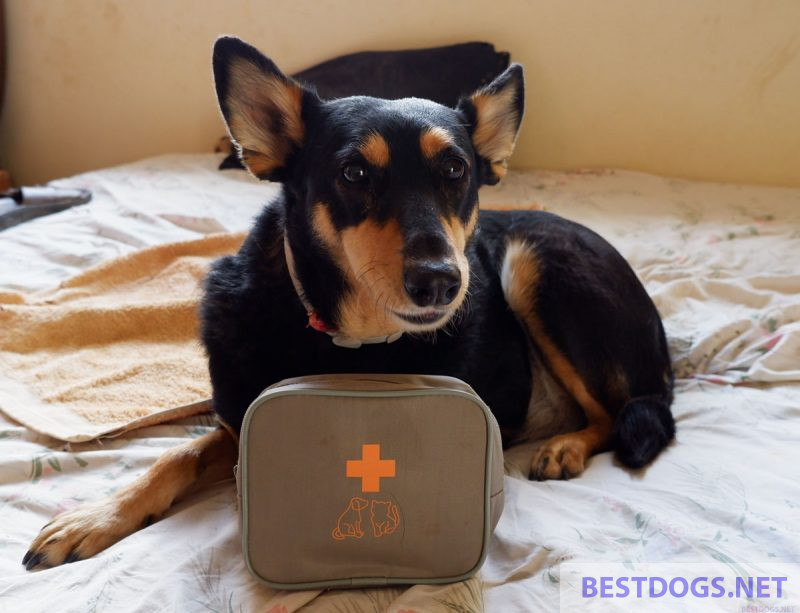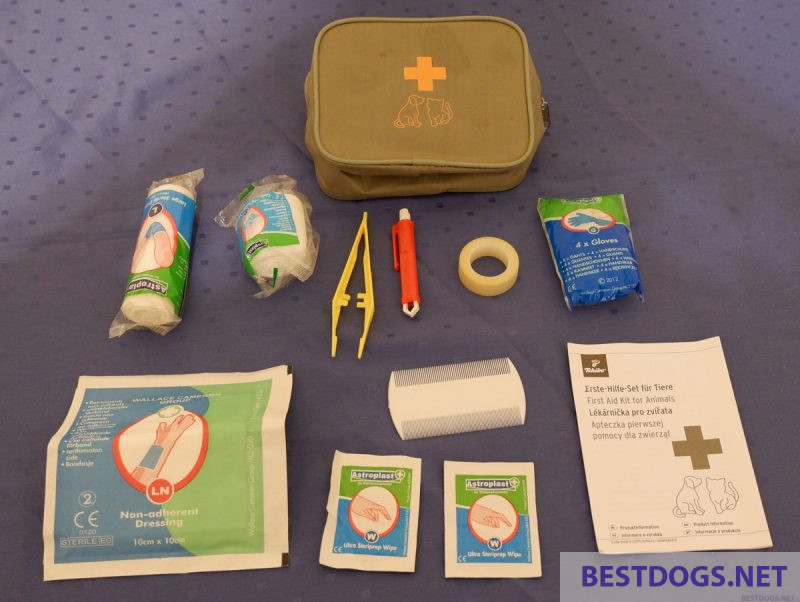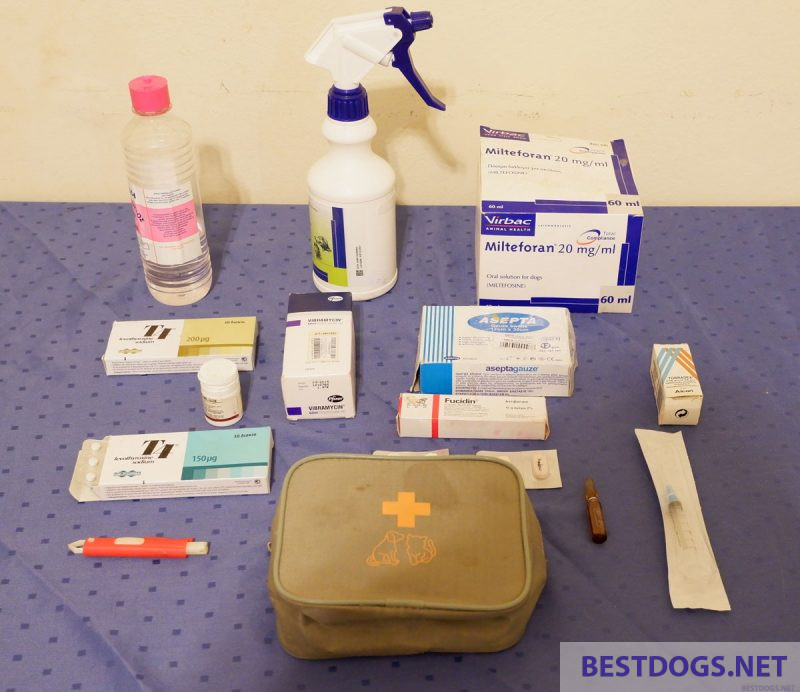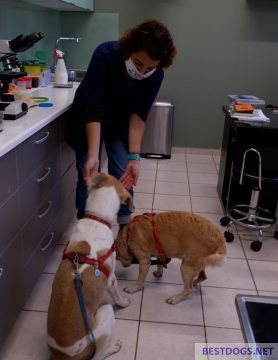Dog pharmacy – the somewhat different medicine cabinet with first aid kit for home and travelling.

Of course, our housemate, the dog, can also become ill.
When the dog gets sick
Table of Contents
Clear signs of this are a change in behavior, listlessness, ruffled and lackluster fur, cloudy eyes, a constantly dry and warm nose, loss of appetite and digestive disorders. Then it is time to pay another visit to his veterinarian.
For this purpose, every dog must be regularly vaccinated against distemper, leptospirosis, contagious hepatitis, rabies and parvovirosis. The time intervals can be found in the vaccination book of each animal, and the inevitable worming must also be done at least once a year – and in southern countries even every three to four months.
Basically, it is better to contact the vet once too much than once too little when a dog might be sick. The dog relies on the master’s alert in time when he is not feeling well, because he can not report himself.
For immediate needs, emergencies and minor aches and pains, the dog pharmacy is intended. However, a veterinarian must be visited in any case of burns, swallowed objects, poisoning, allergic reactions or broken bones after emergency care with the first aid kit.

The dog pharmacy at home
For many dog lovers, the pharmacy for animals at home is essential. The same is true here as with the first aid kit in the car or the first aid kit in the bathroom or kitchen cabinet. Fortunately, these are often not pulled out sometimes for years or even never, but if a crisis does arise with an emergency, you’re glad to be armed. This applies at the same time for the human, as well as with the dog pharmacy for his four-legged friend.
This ‘first aid’ is either for minor aches and pains or to bridge the time until a veterinarian can be visited. In the case of minor aches and pains, the owner can successfully manage and cure a treatment himself without further ado with some expert knowledge and the necessary tools. In the worst case, however, the dog pharmacy offers support, help and relief until the expert treatment with professional means.
Since a disaster rarely comes alone, the telephone numbers and addresses of at least two veterinarians should also always be available. Because emergencies do not always adhere to the consultation hours. Especially during the vacation season or during the night, it is safer to have several options ready to be able to reach a veterinarian in any case.
Knowing a pet transport service if you can’t drive yourself at the moment is also beneficial.
Many of our dogs’ accidents are due to injuries to their paws from sharp objects on the floor, tick infestations, torn claws or ‘wolf claws’, poisoning and so-called ‘house accidents’ such as burns on the stove in the kitchen, tails caught between doors, swallowed objects, or unsuitable food, cleaning supplies or medications lying around.

Equipment of the dog pharmacy
In the dog pharmacy one brings all his medicines, which were prescribed so far by the veterinary surgeon for the own domestic animals, and which one still possesses and is durable. This includes all the utensils and any medicine that you need from time to time due to past experience and regular occurrences. These are for example ear drops for irregularly occurring inflammations or for watery eyes, antiseptic eye ointment.
The basic equipment of the dog pharmacy should consist of the following:
- Clinical thermometer to measure deviations from the normal body temperature of about 101 °F (38.5 °C) for dogs.
- A special tick forceps to remove these pests. The sooner a tick is removed, the less likely it is that a dangerous pathogen will be transmitted. Afterwards, the area should be disinfected with betaisadonas ointment.
- Use flat tweezers to pull out splinters.
- Alcohol-free disinfectant or tincture of iodine for minor injuries with open wounds.
- Antibacterial wound ointment for abrasions or scratches.
- Vaseline (or Ballistol) to relieve pain due to sore, cracked or brittle pads. Injuries to paws and pads can occur from splinters and broken glass, which can often happen at the beach. This can be accompanied by torn claws or torn Dewclaws.
- For sprains, a pain relieving sprain gel.
- Chamomile tea to wash out sore eyelids or frequently watery or irritated eyes.
- Q-tips, cellulose swabs and absorbent cotton for cleaning ear canals, washing out eyes and irritated chaps or sore noses.
- Anti-allergic ointments for swollen, painful insect bites.
- Charcoal tablets or other medications for diarrhea (but not for fever).
The first-aid kit for the dear four-legged friends also includes gauze bandages and elastic bandages, scissors and safety pins.
Dogs in shock or severe pain can be prone to extreme reactions, so a muzzle, a temporary rubber mouth loop or a gauze bandage can be helpful.
In stressful moments, such as during fireworks, after a scuffle and biting, after injuries or even during a long car ride helps a natural, light sedative.
The date for the next rabies can be found in the vaccination certificate, worming medication must be administered at least once a year and in southern countries every three to four months. In addition, flea powder or spray, disposable razors to remove fur during treatments, and nail scissors complete the equipment of the dog pharmacy.
Poisoning
Unfortunately, unpleasant contemporaries put out poison baits or the dog may have inadvertently ingested rat poison or snacked on any medicines, cleaning agents (water bucket with cleaning agent for washing, detergent or prepared, open toilet) in the household.
In the case of rat poison or slug pellets, just sniffing the bait is enough to cause poisoning for dogs. Indications of such, laid out poisons are white or colorful pellets.
Slug pellets show their effect much faster than rat poison, where recognizable symptoms can occur only after hours.
When walking or running in the open air should also pay attention to sprayed pesticides for pest control. These agents are not only effective against insects, but also dangerous for dogs. Especially young, old or sick dogs are at risk and can be poisoned on contact. In places where pesticides have been used, you should therefore refrain from walking your dog for a few days.
Dogs are also at risk within their own four walls from carelessly lying around medicines such as painkillers, sleeping pills, psychotropic drugs and contraceptives.
Some of our foods also act as real poisons to dogs: chocolate, raw pork, potatoes, tomatoes, eggplant, peppers, sweeteners, onion, avocado, french fries, fruits and potatoes, coffee, and alcohol, including beer. Even small amounts of these can be fatal to a dog.
Poisoning is recognized by these symptoms: Unconsciousness or clouding of consciousness, convulsions or paralysis, bloody diarrhea or vomiting, bloody urine, colorless gums, irregular pulse, restlessness and trembling, constricted or dilated pupils, cramped posture, but also apathy and indifference.
After poisoning, activated charcoal can mitigate the effects. About 0.7 to 1 oz (20 to 30 grams) as a powder should be mixed and administered to the dog with disposable syringes.
The dog should not be muzzled as it will vomit, but it should not be forced to vomit under any circumstances.
For the inevitable visit to the veterinarian, some vomit or excrement should be brought along to determine the cause, as well as the toxin itself if possible.





